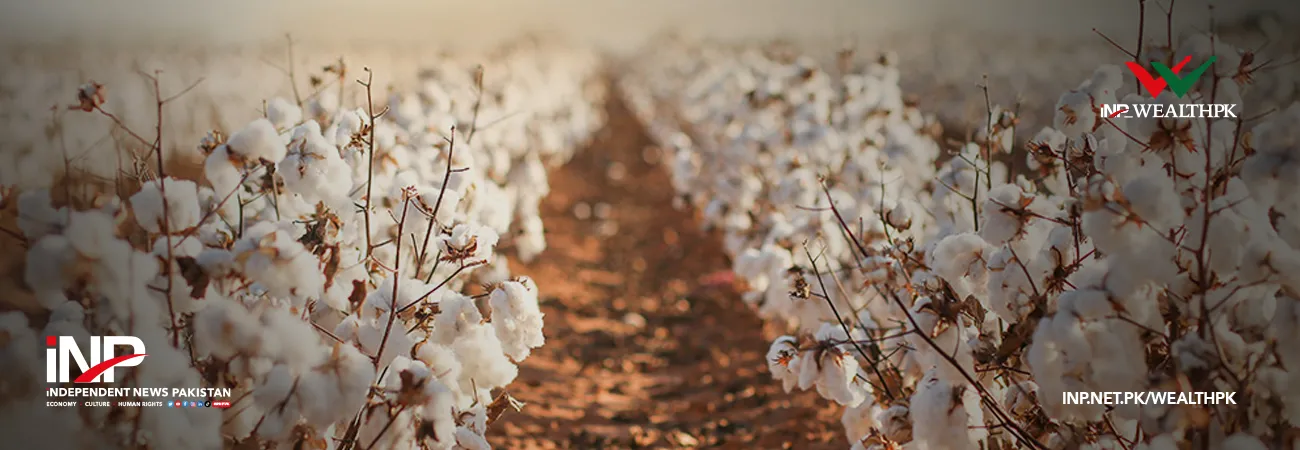INP-WealthPk
Muhammad Faisal Kaleem
The Pakistani government plans to introduce a DNA and isotope-based traceability system to verify the origin of cotton and enhance its quality certification for global markets. The initiative forms part of the draft Textile and Apparel Policy 2025–30, which includes a detailed Cotton Revival Program aimed at improving productivity, climate resilience, and sustainability across the cotton value chain.
According to the draft Textile and Apparel Policy 2025–30 available with Wealth Pakistan, cotton remains the backbone of Pakistan’s textile industry and a key contributor to rural livelihoods. However, the sector has faced recurring challenges in recent years due to adverse weather conditions, declining sowing areas, pest infestations, and outdated ginning practices. The policy emphasizes that stabilizing and modernizing the cotton economy is vital for ensuring consistent raw material supply to the country’s textile and apparel sector.
The draft records that Pakistan has maintained a cotton intervention price over the past three years to ensure fair returns for farmers and to encourage increased cultivation. In 2022, the country’s cotton output dropped to 4.99 million bales due to severe floods, heat stress, and pest attacks. The following year, production recovered by 108 percent to 10.2 million bales because of favorable weather and expanded cultivation. However, production again declined in 2024 to 7.04 million bales, mainly due to above-normal monsoon rainfall and delayed sowing.
To address this volatility, the proposed policy outlines a comprehensive revival plan cantered on improved seed technology, better farming practices, and modern quality management. A cornerstone of this initiative is the establishment of a national laboratory for DNA and isotope-based traceability. The system will allow verification of the origin and quality of cotton produced in Pakistan, ensuring transparency for international buyers and promoting the “Made in Pakistan” brand as a mark of reliability.
The policy also calls for modernizing ginning operations through improved machinery and contamination control measures. It proposes training programs for farmers, ginners, and traders to enhance post-harvest handling and storage practices, with a focus on preserving fiber quality and reducing losses. Access to quality seed, pest management, and climate-smart cultivation methods are highlighted as central components of the revival effort.
To mitigate risks arising from climate change, the draft recommends establishing regional climate observatories in cotton-growing zones. These observatories will monitor weather trends, soil conditions, and pest dynamics to support data-driven decision-making for farmers and policymakers. Crop insurance programs will be strengthened to protect growers against losses from floods, droughts, and pest outbreaks.
The document further highlights the need for coordinated research on high-yield, heat-tolerant, and pest-resistant cotton varieties. It calls for greater collaboration among research institutions, the private sector, and provincial agricultural departments to scale up the use of improved seed technologies and ensure uniform adoption across production regions.
Fiscal and policy reforms have also been proposed to make cotton production more competitive. The draft calls for rationalizing taxes along the cotton value chain, facilitating investment in seed production, and improving access to agricultural credit. These measures are intended to reduce production costs and attract private investment in cotton-based industries.
The policy stresses that improving cotton quality and certification standards is essential for maintaining Pakistan’s export competitiveness in the global textile market. The implementation of a DNA traceability system—developed in collaboration with NTU and supported by EDF funding—includes the establishment of a dedicated DNA/isotopic laboratory for cotton origin testing. Aligned with the Department of Plant Protection (DPP) and international SPS compliance protocols, this initiative enhances the credibility of reporting mechanisms and strengthens adherence to global sourcing standards, particularly those demanded by environmentally and socially conscious buyers in Europe and North America.
The document concludes that the success of the cotton revival plan will depend on coordinated action among federal and provincial governments, research bodies, and industry stakeholders. It expresses confidence that the proposed reforms and technological upgrades will help restore Pakistan’s cotton production capacity, improve product credibility, and reinforce the foundation of the country’s textile-driven industrial growth.

Credit: INP-WealthPk












